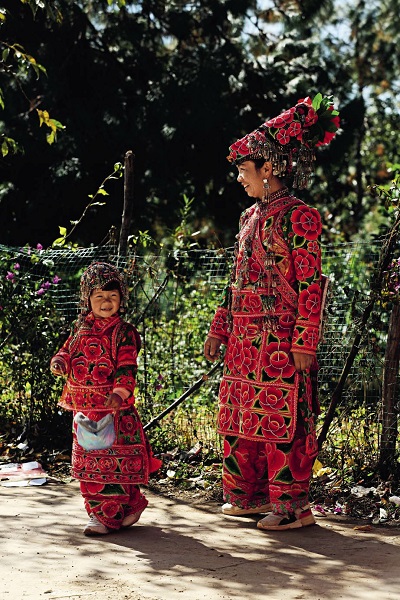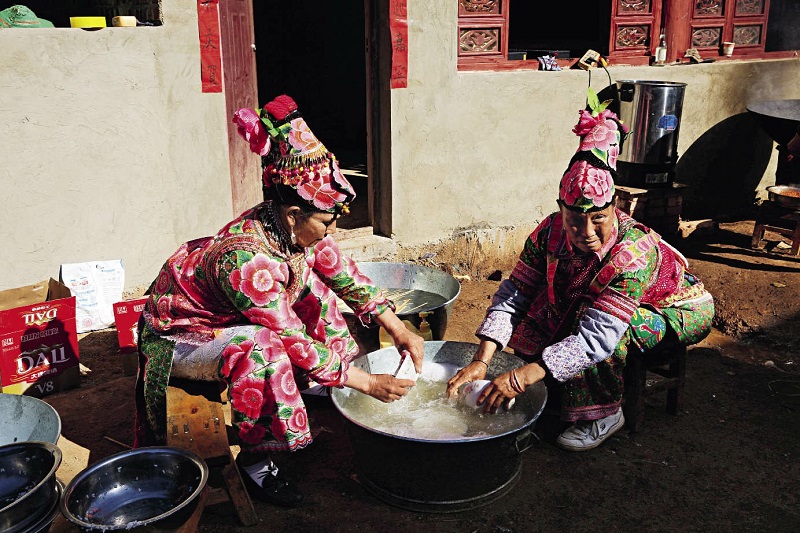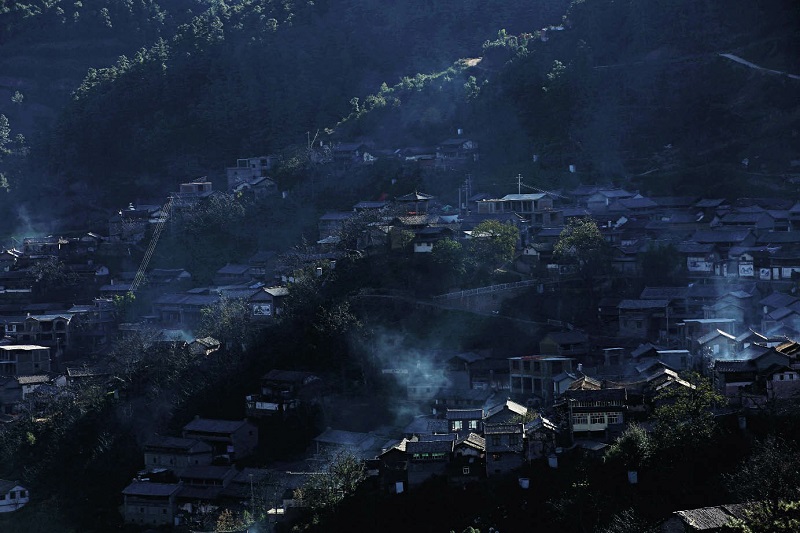
A mother and child dressed up in their beautifully handmade traditional Yi ethnic clothes.
Once upon a time there was a kingdom that flourished in ancient China called the Nanzhao Kingdom (738-902). It prospered and was influential throughout Southeast Asia, during the years of the Tang Dynasty (618-907). Various ethnic groups thrived in the kingdom, but the one that held the most power in government was the Yi people. They governed the large region containing hundreds of rivers and integrated the political, economic, military strengths and folk customs of other ethnic groups. The Yi language (both in its written and spoken form) was the official language of the day. During the more than 100 years of its existence, Nanzhao enjoyed peace and prosperity. It was also during this time that the local culture of singing and dancing flourished. Later, when the Nanzhao Kingdom was overthrown by an influential official surnamed Zheng during the late Tang Dynasty, almost all members of the Nanzhao Kingdom’s royal family were executed. The few who survived took refuge deep in the mountains, while other loyal subjects of Nanzhao were forced to leave the doomed region of the Weishan basin and migrate even deeper into the mountains, finally basing themselves in the region now known as the Weishan Yi and Hui Autonomous County.

A group of Yi people enjoy traditional music and dancing.
Passion for Singing and Dancing
Weishan Yi and Hui Autonomous County, the birthplace of the Nanzhao Kingdom and the ancestral home of the Yi ethnic group, has cultural traditions that have been maintained and developed for thousands of years. During the ethnic traditional Torch Festival, Yi people make their way back to Weishan Ancient Town to sing and dance, something they are passionate about. An old local saying says, “Their feet begin moving at the sound of the reed-pipe instrument and voices begin singing at the sound of the flute.” At a wedding I once attended in new Zhuomulang Village, hidden deep in the mountains, before the arrival of the newlyweds, the singing had already begun. One person began playing a reed-pipe instrument, while two people holding knives in their hands began to dance a traditional knife dance at the wedding venue. As the music continued, the rest of the people started to dance in a circle and sing their traditional folk songs.
Regardless of gender or age, everyone who is part of the Yi ethnic group can sing and dance, skills that are an inseparable part of their lives. Occasions like New Year’s Day, temple fairs, weddings, and funerals will all include singing and dancing. In addition, performances are given to commemorate the 100th day after the death of an elderly person and honor the three year marker for exhibiting filial piety in mourning for a person’s deceased parent, as well as even after showing a movie in the village.
Blind dates and engagement ceremonies also cannot be held without music and dancing. The style of songs sung in the Weishan region differs between mountain regions. Each area exhibits the unique customs of the eight villages spreading over the four main mountain areas. For example, the singing style of the Zhuomulang Village located in the eastern region is relatively calm, elegant, and gentle. After someone begins a song, people dressed in their traditional clothes join in by humming the melody. Others then join in after being playfully persuaded by friends. As the number of people singing increases, the sonorous sounds that have continued for hundreds of years bring the simple and unique melodies alive.

Two Yi women make preparations for a wedding feast.
Village Life
Zhuomulang is located in Dacang Town, Weishan County, Dali Bai Autonomous Prefecture in southwest China’s Yunnan Province. The village is more than 2,000 meters above sea level and enjoys an alpine mountainous environment. Animal husbandry in the village is well developed and almost every family raises cattle, sheep, horses, donkeys, and other kinds of livestock. The mountain roads are rugged and terraced farming and transportation rely mostly on horses and cattle as farming machinery is ineffective in this terrain. Local people maintain the traditional self-sufficient life of farming, working in the field from sunrise to sunset. In order to solve the villagers’ traveling difficulties and improve healthcare, the government built a road and established a clinic not far from the village. However, when sick, locals are more inclined to seek medical treatment from their local Yi medicine practitioner.
Over the centuries of traditional life, the Yi people in the Weishan mountain regions have taken advantage of rich local resources of plants and animals, and through much research, accumulated a wealth of medical knowledge and treatment methods with distinct local characteristics. The Weishan County area is home to a wide variety of medicinal herbs. Yi doctors utilize traditional herbal medicine made of local raw materials, with good results in the treatment of intractable diseases.
According to certain village elders in the eastern Weishan mountain region, Yi people in Zhuomulang Village are closely related to the descendants of the Mengshe royal family of the Nanzhao Kingdom. Many of their legends say the descendants of Princess Mengshe hid in a cave to escape the extermination of the Nanzhao Kingdom’s royal family by rebels. After entering the cave, a spider appeared and formed a complete spider web at the front of the cave. When the rebels passed by the entrance and saw the undisturbed spider’s web, they thought there was nobody inside. After they left, the princess’s descendants escaped to safety. In order to commemorate their rebirth, the Yi people enshrine spider totems, carve exquisite spider patterns on their traditional garments, and use many spider patterns in their traditional paintings, keeping their traditional cultural customs intact.
The old Zhuomulang Village was built according to the geographical layout of the mountain from the bottom up. House designs include earth-wood tile-roofed houses, adobe houses, and wooden houses. Each house includes the father’s main room, mother’s room, children’s quarters, the storage room for supplies and grain, and a side room for storing animal feed. The function of each room is distinct and practical.
Due to geological dangers in the old Zhuomulang Village, 28 families were moved to a newly built Zhuomulang Village. In the new village, families live in three-tier reinforced concrete buildings that are decorated with carved patterns or woodwork designs on the doors and windows, and painted walls, exhibiting their multi-ethnic culture. The young villagers all enjoy living comfortably in the new style of houses; however the elderly people still prefer the traditional tile-roofed wooden houses.
Most Yi families in Weishan live as a family unit with three, four or even five generations all living under one roof. Traditionally, the role of men is head of the family, while women take care of the home. The Yi attach great importance to kinship and educate future generations to respect the elderly and love the young. They are also taught to live economically, not to use foul language, and not to gamble or steal.

A stunning view of a traditional Yi mountain village.
Beautiful Clothing
For thousands of years, the ancestors of the Yi people used their wisdom and hard work in this ancient land to create a magnificent culture. As an indelible cultural symbol, the Yi people’s clothing in the Weishan mountain region can trace its history back to the Qin and Han dynasties and became increasingly more beautiful in design during the Nanzhao Kingdom period. The people of Zhuomulang traditionally like to wear clothes in bright red and green, or dark pink and yellow colors, and decorate them with flower patterns. Women’s traditional apparel is beautiful and colorful, exhibiting the traditional cultural characteristics of ancient Nanzhao royalty.
The clothes and accessories which Yi people wear are all hand sewn by Zhuomulang women, who are skillful and resourceful with their hands. Women rarely leave their valleys and spend most of their time carrying out duties at home. In addition to embroidery, they are more responsible for physical work such as feeding horses and raising cattle. According to the older generation, before getting married, a young lady must prepare more than 20 sets of clothes, more than 30 aprons, dozens of pairs of embroidered shoes, comb their hair into a towering bun, and prepare a number of head scarfs for wrapping their bun at different ages in their life. Mothers are responsible not only to embroider their daughters’ wedding gowns, but also teach them how to embroider. In Zhuomulang Village, you can see working people wearing their Yi traditional clothes everywhere. There are two types of women’s clothing: daily wear clothes and formal clothes. The daily wear clothes are bright in color but more suitable for work. Wearing formal clothes, however, do not hinder women from carrying out their work duties.
The clothing worn by Yi men basically resembles the style of the Chinese Han ethnicity, while at the same time retains the traditional custom of wearing animal skin gowns, sheepskin blouses, and embroidered shoulder bags.
The mountainous region of Weishan County is rich in flowers and flora, and designs of these flowers are used to decorate the clothing of the Yi women. Yi women allow the fragrance of the flowers to freshen up their homes. Every household in Zhuomulang Village grows a kind of fragrant orchid called Eupatorium fortunei. The people bring flowers back from the ravines and meadows of the surrounding mountains when they take their cattle and sheep out to graze. This orchid was highly respected by local scholars of the past dynasties, and used in descriptions of character development like the saying, “After some time of being in a room where orchids are, you will not be able to smell their fragrance because you will have become part of the fragrance.” Such highly appreciated flowers grow wild in Yi people’s courtyards, and with their fragrance the flowers fill the lives of Yi people with beauty and happiness.
ZHAO YANQING is a travel columnist.